The second segment of our South American cruise began in Rio de Janeiro, Brazil and took us to many more Brazilian cities before we made our way to Uruguay and Argentina. There were several surprises along the way such as Buzios and its connection to Brigitte Bardot. Parati, which is on the tentative list to become a UNESCO World Heritage Site. Punta del Este, Uruguay, an upscale, cosmopolitan resort town was quite a contrast to most any other port we visited. And the surprising continued popularity of Eva Peron, or Evita, in Buenos Aires, Argentina.
New Faces on Board ms Sirena
Upon our return to the ship from Iguazu Falls, we were immediately struck by the number of new faces. About two thirds of the passengers left ms Sirena in Rio annew passengers embarked while we were in Iguazu Falls.
We noticed that the passengers seemed a bit younger on this segment of our South American cruise. Then it occurred to us, since this segment was only 12 days long, it fit into a two week vacation; our ship was no longer filled with retirees. The new passengers included alumni groups from several American universities, which added in a new twist.

Touring Rio
“I’m glad I’m not driving!” was one of my first thoughts as we slowly snaked our way to Mount Corcovado. Traffic was crazy and the streets ran every which way. Our guide pointed out the Sambadrome as we drove past. This is where the samba competitions take place each year during Carnival. The Sambadrome is relatively new, originally opening in 1984 and was upgraded for the 2016 Olympic Games. The 20 plus samba schools compete over a series of nights during Carnival. Dancers must complete the 700 meter journey in one hour, 15 minutes, dancing the entire time! Even though we only saw the outside of the large concrete facility as we drove past we could see work was ongoing, as Carnival was only a few weeks away.
Christ the Redeemer
We finally made our way to the base of Mt. Corcovado, the location of the statue, Christ the Redeemer. Once we arrived a train, elevator and escalator transported us up the 2,310 feet to the summit. At the top is the imposing 98 feet tall statue, mounted on a 26 feet tall base. The views of the immense city of Rio from the top of Mt. Corcovado are amazing. Due to the large number of inconsiderate ‘photographers’, my experience was not as good as I had hoped. I’ll go more into that at a later date.
I do recommend you visit the statue, but, bring along a hefty dose of patience and flexibility. We experienced a few minimal wait times on our visit. However, in reading reviews on Trip Advisor, it sounds as though there can be long waits and at times the trains, elevators and escalators experience outages.
More of Rio
There was a lot more of Rio to see on the rest of the tour. I was disappointed that we didn’t get off the motor coach at any other locations. I would have liked to have walked on the beaches of Copacabana or Ipanema. We only saw them as we drove by.

Rio de Janeiro was, at one time, the capital of Brazil. We drove by the very elaborate former presidential palace where governor of the state of Rio de Janeiro now resides. An all day tour of the city would have provided more stops, but, in my opinion, four hours touring a city on a motor coach is enough.
Buzios and Brigitte Bardot
Our next port of call was a cute little seaside village located on a peninsula about a two hour drive from Rio. This sleepy little fishing village was used by the actress, Brigitte Bardot, to escape from the paparazzi which put Buzios on the map. Once word got out, the village turned into a vacation and resort community. According to our guide, just after Christmas the tourists arrive and the population of Buzios explodes from 35,000 to one million. Fortunately, it was the end of the season and the village was returning to normal.
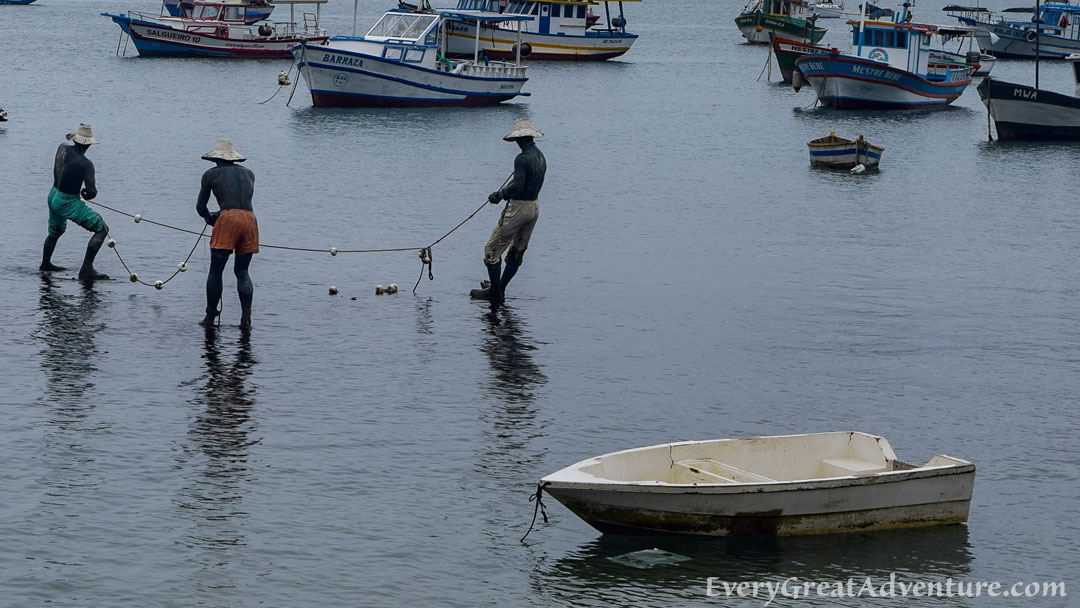
Our tour began with a drive along the beach in town. I was intrigued at the three fishermen in the water; surprised they were fishing so close to the beach. Our guide announced, “We will pause here a moment so you can see the three fishermen…” (I was finishing her sentence in my mind, “…pull in their catch.”) When she said, “… statue”. Then it occurred to me; none of these men had moved a muscle! Yes, they were indeed life sized statues of three fishermen pulling in their net.
Beaches in the Rain
The tour included many beaches of the area. However, since it was pouring rain, everything was cast in gray. Our tour guide did her best. She shared pictures of the beaches she had on her phone. She wanted us to see how beautiful the beaches were in the sunlight. There were a couple of stops to view the beaches, but, few people ventured into the rain.
A Lovely Walkway
By the time the tour ended, the rain was letting up, so Art and I decided to walk around the village for a bit. There is a stone walkway that spans the beach, making for a lovely walk. It was about 11 a.m., and the restaurants were putting out tables and chairs, and people were beginning to venture out.

In addition to the statues of the fishermen on the beach, there are a couple of other life sized statues on the boardwalk. The most famous is the statue of Brigette Bardot. We helped a lot of folks take pictures with Brigette. I am sure we had someone take our picture with her, but I am at a loss to find it. The other statue is of the former Brazilian President, Juscelino Kubitschek, who is most famous for moving the capital of Brazil from Rio de Janeiro to Brasilia. Again, I am sure I took a picture of this statue, but it is no where to be found.
Ilha Grande
Tenders took us into the village of Vila do Abraao on Ilha Grande. Armed with umbrellas we, once again, braved the rain. Our tour guides, Olivia and Carlos, greeted us at the end of the pier. The walking tour began with a short overview of the village followed by a stop at the tourist center, where Olivia shared a little more about the history of the island.
Olivia explained that hundreds of years ago, the Dutch burned the natural vegetation to clear the land for coffee plantations. As a result much of the indigenous flora was destroyed. The island has now been designated a preservation area, and a great deal of the flora has returned.
Lazareto
We followed our guides out to the national forest. First stop, the remains of a hospital turned prison, located right at the water’s edge. The hospital, known as Lazareto, was used to quarantine immigrants before they were allowed to proceed to the mainland of Brazil. It was later a sanitorium for leprosy patients. By the early 1900’s it was converted into a prison, Colonia Candido Mendes, housing the nation’s most dangerous criminals, including the criminally insane.

In the late 1950’s the prisoners were moved to another facility, which was closed in 1994. All that remains of the original hospital/prison are ruins of the lower part.
An 1800’s Aqueduct
We then hiked up a hill, which was a little difficult in the rain. Our guides showed us the remains of an aqueduct built in 1893. It was constructed with sand, stone and whale oil. We had the opportunity to get in the water at a nearby waterfall, but no one did, as we were already wet from the rain. Then it was a short hike back into town where the tour ended.
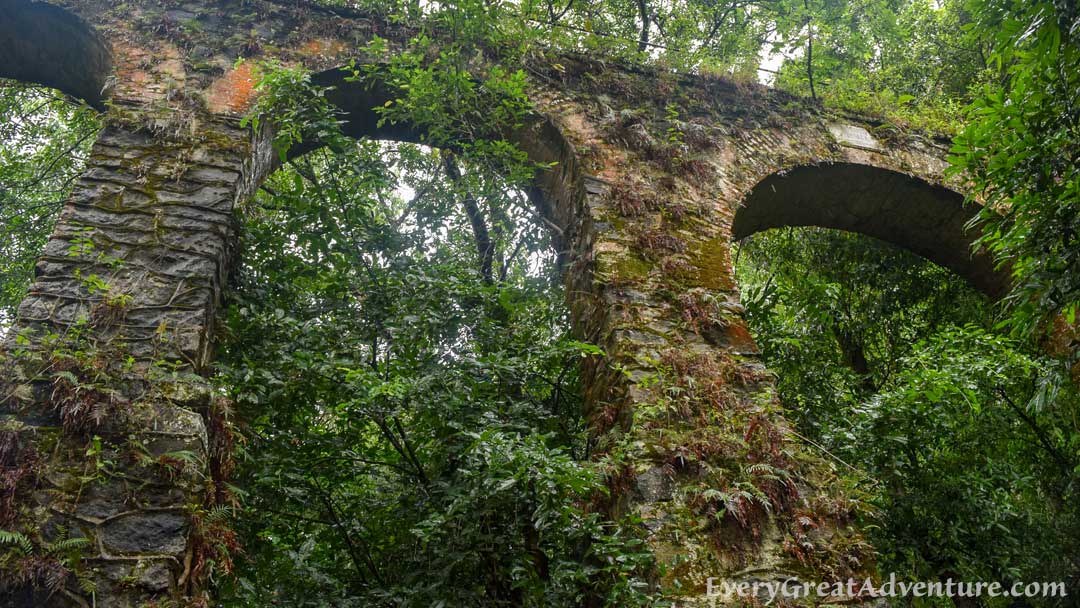
During our hike people had a tendency to get a bit strung out as we went along. As a result some people could not hear the guides as they pointed out things along the trail. Our group had over 20 people in it, ten would have been a better number. Other than that, I enjoyed the tour and thought it went well. Of course the rain was inconvenient, but no one can do anything about that.
Pretty, Parati, Brazil
Another tender ride was required to take us to our next port of call, Parati. As we watched from our stateroom, we saw a nice blue, yellow and white schooner pull up to the ship. We thought it was for one of the shore excursions. As it turned out, in some of the ports, the ship lined up local boats to use as tenders. It kept things moving a little faster and it was a nice change of pace for us passengers. We lucked out and were on the schooner we saw. We enjoyed having plenty of room, lots of fresh air and the ability to stand up and walk around a bit on our way into the port.

It was Friday, and it appeared that the locals were gearing up for a busy weekend. The sun was shining and the pier was buzzing with activity. At the end of the long pier was a directional sign pointing the way to the old town.
Parati was, at one time, one of Brazil’s most important harbors. Brazil had it’s own gold rush, and Parati was the point from which the gold was exported. The old town dates back to the 1700s and is very well maintained. The beautiful colonial era buildings have been repurposed to house restaurants and shops. As no cars are allowed in the old town, you can freely walk along the streets. The Gold route in Parati and it’s landscape, are on the Tentative List and will hopefully, one day, become a UNESCO World Heritage Site.

Cobblestone Streets
The streets, made of large stone embedded in the ground, turned out to be the most difficult thing about Parati. Unlike the cobblestone streets in the US, the stones are not pushed together, rendering them very difficult for the uninitiated to walk on. However, we noticed that the locals walked on them with ease.
We learned there was a reason for this design. When the tide comes in, the streets flood. The large stones stay in place but much of the dirt between the rocks washes away. Since sidewalks were few and far between, we made our way on the street, stepping from stone to stone. Many of the men thought Parati was one of the best ports of call on this segment of our South American Cruise. They said their wives were so preoccupied with watching their step, they never even noticed they shops they passed.
Fiddler Crabs
The ends of some of the streets still fill with water when the tide comes in. As a result there are colonies of fiddler crabs among the cobblestones. I have always been intrigued by fiddler crabs with their claws, one nearly as large as their tiny body and the other seemingly useless in comparison. They are such feisty little creatures! I spent some time watching them and capturing them on video.
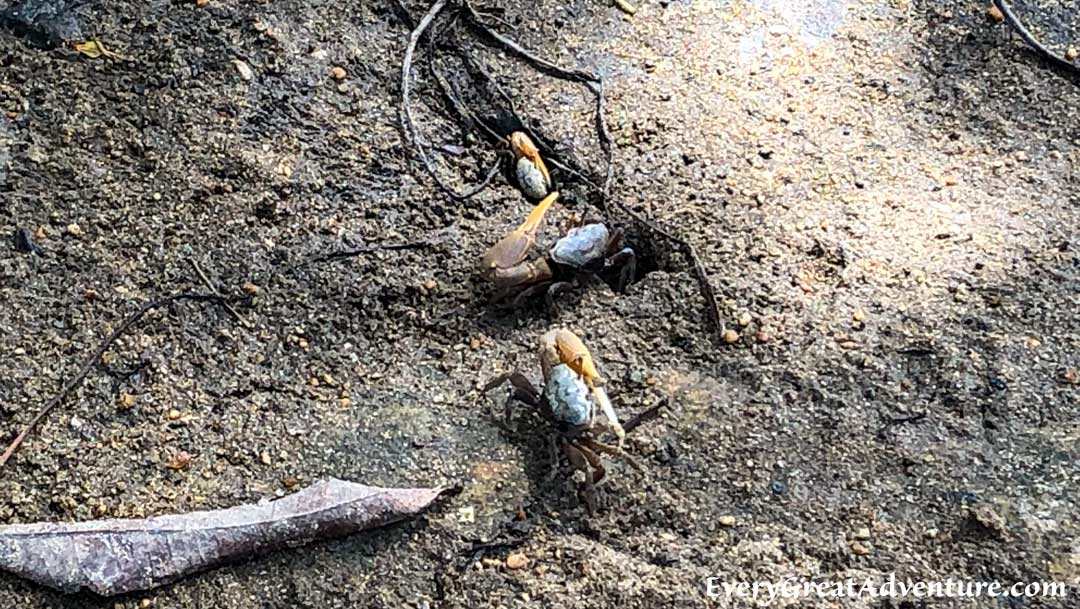
A Soggy South American Cruise
People often ask us, “What do you do when it rains?” First of all, we come prepared; always traveling with water repellant jackets. It never hurts to pack a small collapsible umbrella either. I bring an assortment of zip top plastic bags in a variety of sizes. They are great for keeping cell phones, cameras and other items dry and take up very little room. Plus, you can use them to hold smaller items in your suitcase.
Learn to Dance in the Rain
We have a little plaque at our house that reads “Life is not about waiting for the storm to pass. It’s about learning to dance in the rain”. When traveling on a cruise, it is typical to spend, maybe, eight to 12 hours in a port. This may be your only opportunity to see this location. Sometimes, you just have to deal with the weather, whatever it may be. Typically, unless the weather will jeopardize our safety, we just go for it. There have been days when the morning’s weather was simply horrid, but beautiful in the afternoon.
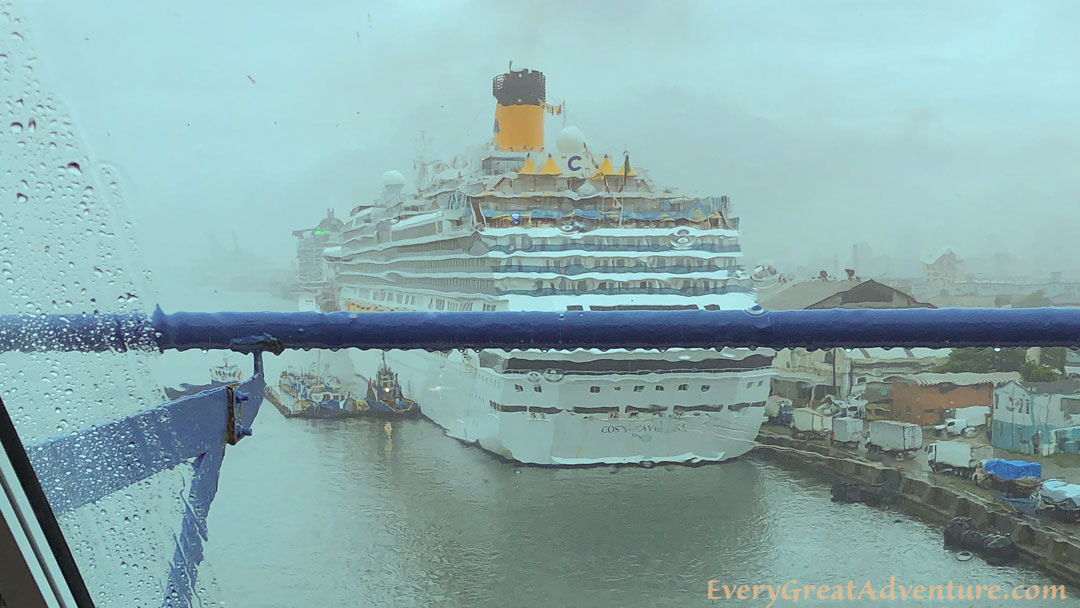
Santos, Brazil
Santos was the port of call for Sau Paulo, Brazil, the third largest city in the world! The shore excursion from Santos into Sau Paulo was nine hours in length, with only four stops, one of which was for lunch. So, Art and I decided it would be way too much time on the motor coach for us.
As you can see in the picture above, it was another rainy day. We waited for the rain to let up, and then took the shuttle into Santos, which happened to stop at a shopping mall. It looked like we were in the middle of a business district, so we just walked the modern three story mall a couple of times. We thought we would venture outside to see if there was anything else in the area, but the rain started up again. So, back into the mall we went, where we waited for the next shuttle back to the ship. Sorry to say, but that was our day in Santos.
Porto Belo, Brazil
This was a very stormy day, heavy rains, thunder and lightning. We didn’t have a shore excursion planned for this port, so we decided to stay on board the ship.
Change is Not a Four Letter Word
It’s okay to change your plans, if your not feeling well, or the weather is not to your liking. If you were planning a beach day and an all day rain is predicted, you might decide to not go. Just remember, if you have a tour planned through the cruise line, you have to cancel before the deadline in order to receive a refund. If it’s going to be an all day rain, head off for an indoor activity instead; go to a museum or two. Find a nice little café, have a coffee and soak up some of the local ambiance.
If worse comes to worst, you can always stay on board the ship, as we did. It’s not a sin. Head off to the library and read a book. You might find the computer room empty, so you can catch up on emails. I’m sure your friends will have a great deal of sympathy as you lament about a rainy day on your cruise. (Especially if your rainy day is accompanied by 80 degrees and their day is snowy and 25 degrees!) Book a manicure or spa treatment; they often have last minute appointments available on shore days. What ever you do, remember, you’re on vacation; just relax and enjoy it!
Rio Grande
Our arrival was quite festive as we were greeted by a group of teenaged dancers as we disembarked the ship. There was a shuttle into town, but they must have underestimated the number of people who wanted to take it. Unfortunately, some of our fellow passengers showed their ugly side and made a bit of a scene while we waited for additional motor coaches to arrive. It was embarrassing. At any rate, after a short wait we were on the shuttle into town.
Rio Grande was founded in the 18th century and is another good example of Brazil’s colonial period. We walked through a lovely park, with what appeared to be empty bird cages. The park was obviously past it’s prime. But, it was still a shady respite from the sun, and quite enjoyable.

Truth be told, of all of our ports of call on this South American cruise, Rio Grande was, probably, the least well liked. I was in the minority, I liked it.
The old town area where we were, was definitely deteriorating. But, you could still see its beauty. There were buildings we could see that they had torn down the majority of the structure while maintaining the façade. I applaud those who are trying to preserve what they are able. With a large infusion of cash and a great deal of effort, this town could easily rival Parati.
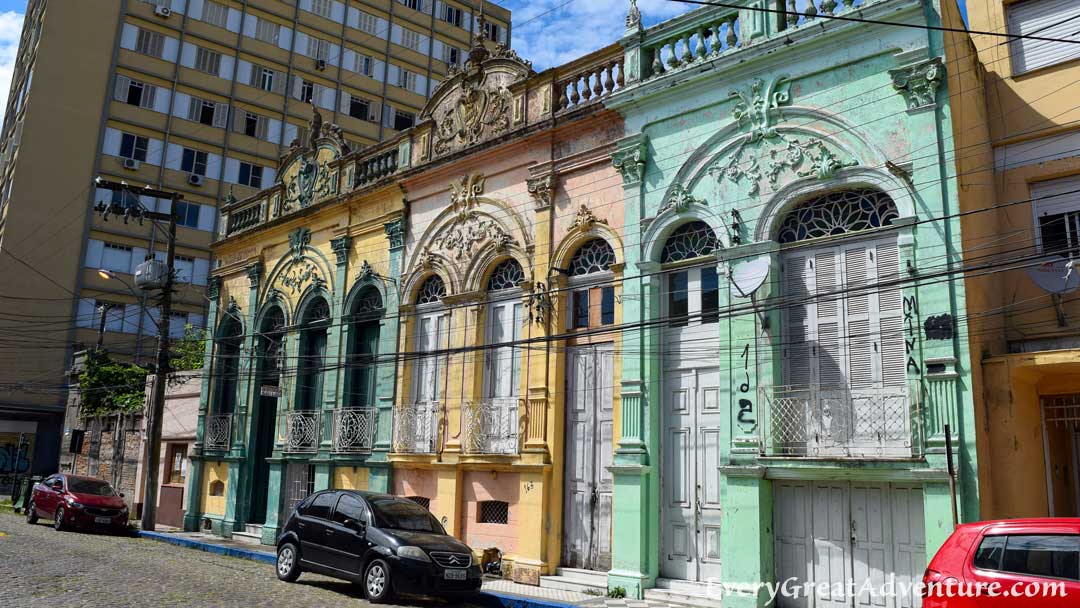
Hotel Paris
We went into a couple of churches, but my favorite place was the Hotel Paris. It is still in operation, and must have been amazing in it’s day. Obviously, they are trying to keep it fairly true to it’s original state. I could just imagine men and women in traditional dress walking through the courtyard near the fountain. As I walked through to the back of the hotel, I saw sheets and bed covers drying on the clothes line. It was truly a walk back in time.

Punta del Este, Uruguay
Our South American cruise allowed us just over three weeks in Brazil. We were now moving on to other countries. Our first stop was Punta del Este, Uruguay. What a change! The rain disappeared, and the sun was brilliant. The city was bright and clean, with modern buildings. The normal population of the city is about 10,000; but in the summer is home to more than half a million. We were there at the tail end of the summer season, so we felt like we had the city to ourselves.
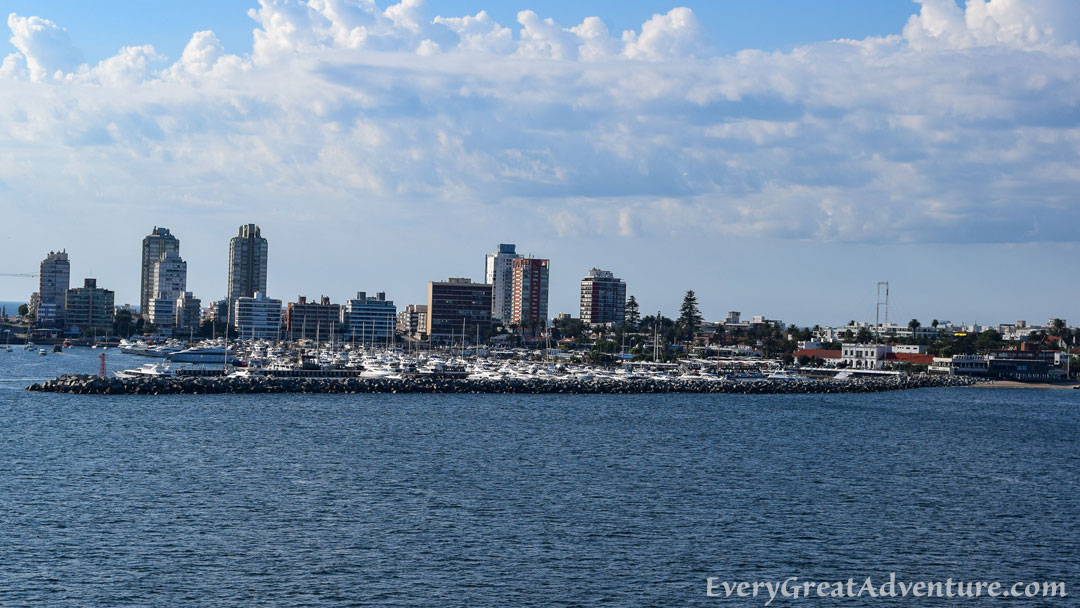
Unfortunately, Punta del Este is not representative of all of Uruguay. This is where the rich and famous of South America go to play. However, it is beautiful, and I’m glad we were able to see it. I wouldn’t mind coming back here and staying for a week or two.
My Three Recommendations
If you have the time, there are three things you should see in Punta del Este. The easiest to see is what is commonly called the Hand in Sand sculpture. La Mano (the official name) was created by the Chilean artist Mario Irarrazabal in 1982, and has become the symbol of the city. You can easily walk to the sculpture, located just over a mile away from the pier. If you’d rather not walk, cabs are available at the pier.

For those of you who are art enthusiasts, take the time to go up to the area of town known as Beverly Hills. Located amongst the mansions is the Mueso Ralli. This museum houses the works of many of the most talented artists of Latin America, as well as works of Dali, Chagall and other European artists. We talked to several people who went there and they said it was fantastic. It is easily accessible by taxi from the pier.
A Must See
My third recommendation is Casapueblo. Casapueblo was constructed over a 40 year period by it’s owner, Carlos Paez Vilaro. Vilaro, an artist, built it to be his home and a museum for his artwork. It is now a hotel and museum. Just the building alone is spectacular. I did not know this artist’s name prior to our visit, but I did recognize his art.

It is about a 20 or 25 minute or so taxi ride from the pier to Casapueblo, located in Punta Ballena. We hired a cab to take us there, wait while we toured the museum, and bring us back for about $55 USD. Museum admission is $10 USD for adults (ages 12 – 64) $7 USD for seniors (age 65+) and free for children 12 and under. Simply tour the museum at your own pace. This was one of the most memorable places we visited on this segment of our South American cruise.
Montevideo
Our next stop was Montevideo, the capital of Uruguay. This is a great city for a port call. The ship was docked close to the entrance of the port. We were able to walk off the ship, and about a block later were in the city. This city is designed for walking. A pedestrian walkway goes from the pier right into downtown, perhaps a mile and a half in length.
Art and I elected to venture around town on our own as we would be stopping in Montevideo again on the next segment of our South American cruise. As we walked into town, the shops were not yet open. As we passed by city hall, there was a wedding party coming out.
Historic Downtown
We went into the Montevideo Metropolitan Cathedral located on Constitution Square. In use since 1804, we were take aback by how large it is. We continued walking until we got to Independence Square. There we admired the art deco Salvo Plaza. The tomb of Uruguay’s national hero, Jose Artigas is here, along with the gateway to the city, Palacio Estevez (the former seat of the government), and the Solis Theater.

We decide to walk a different route back to ship. This allowed us see a bit more of the real Montevideo, where people live and work. Like many cities, there were a few areas that looked pretty run down, but overall, we were pleasantly surprised with how active it was. Once again, we were struck with the artwork on buildings. There are some incredibly talented artists out there!

After we got back to the ship, we realized that we didn’t see the Tango Museum while we were in town. We decided that we could visit it when we came back in a few days.
What’s New, Buenos Aires?
This was a stop we were really looking forward to, and we were not disappointed; the capital of Argentina, Buenos Aires. One of our favorite plays is Evita. (We even liked the movie with Madonna and Antonio Banderas.) Eva Duarte was an entertainer who married Juan Peron and as Eva Peron, or Evita, became the First Lady of Argentina. Some saw her as an opportunist, others revered her as saintly. It’s obvious, no matter how you feel about her, Eva Peron had, and still has, a great deal of influence over Buenos Aires.
We elected to take one of the ship’s tours of Buenos Aires. Since we were interested in learning more about Eva Peron, we chose the tour that included the Evita Museum. We boarded the motor coach at the customs building and were whisked off to the downtown area. Okay, whisked is an exaggeration, it was a weekday, so there was the requisite traffic to deal with. First we passed by the Government House, known as Casa Rosada for it’s pink color.

Plaza de Mayo
We stopped for photos at Plaza de Mayo, located in front of Casa Rosada. From there walked to the Buenos Aires Metropolitan Cathedral, or, the Pope’s Church as it is known today. This is the church where Pope Francis led mass as the Archbishop of Buenos Aires. Here you will find a ceremonial guard, as the church is also the final resting place of General Jose de San Martin who liberated Argentina, Chile, and Peru from Spanish rule, and the Tomb of the Unknown Soldier of the Independence.
Evita
After reboarding the motor coach, we traveled through the city as our guide pointed out places of interest. One such place was a ministry building adorned with an iron portrait of Evita. We drove though town and several different neighborhoods before arriving at the Recoleta cemetery. Here we did a brief tour and then stood in line to see the Duarte family mausoleum, the final resting place of Eva Peron.

Not too far from the cemetery was the Evita Museum. Inaugurated in 2002, on the 50th anniversary of Evita’s death, the museum is dedicated to her history and good works. The museum is in a home that the Eva Peron foundation purchased and used as a women’s shelter. I thought the museum was quite well done, and it takes about 45 minutes to an hour to see.
La Boca
Our last stop was in the colorful neighborhood of La Boca, known as the birthplace of the tango. It’s filled with shops and cafes. The walls are brightly painted and you might notice some interesting effigies of famous people here and there. I’d recommend that you visit the area if you can, just remember, it’s a very touristy and visually stimulating area; pick pockets know that you will be distracted and vulnerable.
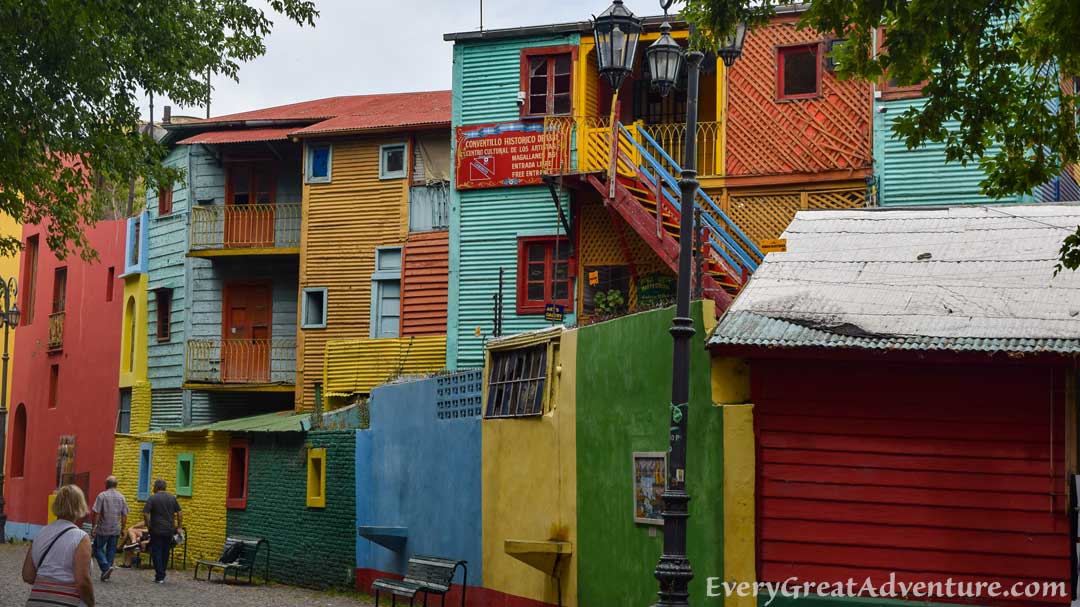
Saying Good-bye, Again
We were shocked to realize that we had been sailing for over a month and the second segment of our cruise was now ending. It was sad to say good-bye to those who had been on the cruise with us since the beginning. But, new friends and adventures awaited as we prepared for the next segment of our South American cruise. (If you missed them, you can read about our first segment of the cruise and our side trip to Iguazu Falls! Check out the accompanying photo journals too.)
How about you? Have you visited South America? Any tips you’d like to add? I’d love to hear about your experiences!
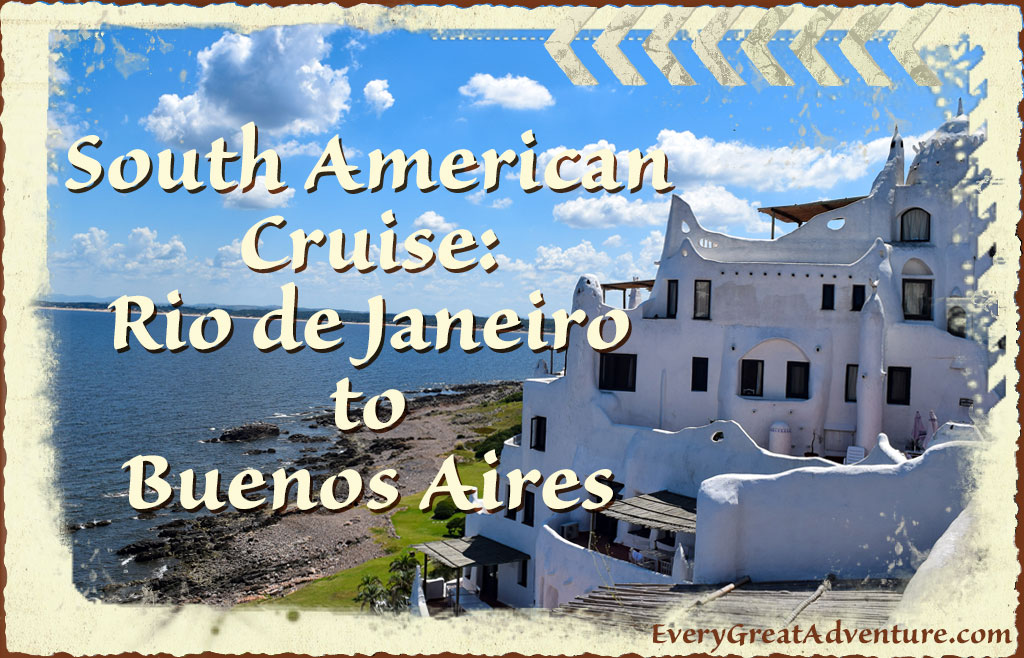

0 Comments